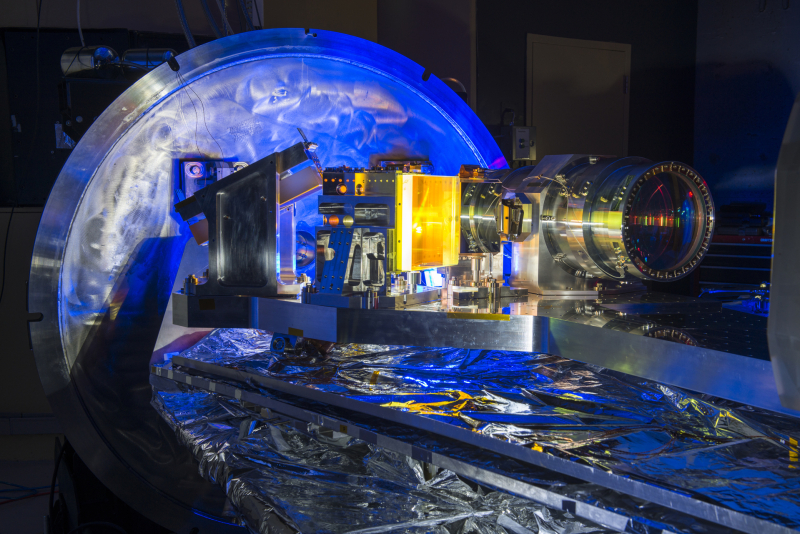Small planets in orbit around red dwarf stars have been detected
An international team, involving CNRS-INSU laboratories, has conducted a study that led to the discovery and characterization of a new planet named TOI-1695b. Barely twice as big and six times as massive as Earth, and slightly smaller than Neptune (hence its designation as a sub-Neptune), it orbits its red dwarf star in only three days. Its atmosphere most likely contains large amounts of hydrogen, helium and water vapor. This discovery will help researchers to better understand how such planets, absent from our solar system, can become during their formation, gas planets for some, or rocky planets for others, despite similar initial masses.
The discovery and characterization of TOI-1695b were made possible by two instruments, the SPIRou spectropolarimeter and the TESS satellite. SPIRou has the particularity to observe in the infrared, which allows the search for planets around smaller stars: the red dwarfs (1) , the most numerous in our galaxy. The extreme stability of SPIRou allows in particular to detect the tiny movements of the star induced by the planets in orbit, and to deduce the mass of these planets: a tour de force for this cryogenic instrument cooled at the temperature of liquid nitrogen (-200°C).

A few weeks ago, the team had announced the discovery and characterization of the sub-Neptune TOI-1759b and the super-Earth TOI-1452b, also orbiting red dwarf stars. The size of these new planets is between 1.7 and 3.1 times that of the Earth, and their masses between 5 and 7 times that of the Earth. They are therefore intermediate planets between the Earth and Neptune, but much closer to their host stars. These discoveries confirm that such planets, although non-existent in the Solar System, are very abundant in our galaxy.
Notes
- Temperature between 2500 and 4000°C, while the Sun is at 5500°C.
CNRS laboratories involved
- Institut de Recherche en Astrophysique et planétologie (IRAP – OMP) – Tutelles : CNRS / CNES / Univ.Toulouse III Paul Sabatier
- Institut d’astrophysique de Paris (IAP) – Tutelles : CNRS / Sorbonne Université
- Laboratoire d’études spatiales et d’instrumentation en astrophysique (LESIA –Obs Paris) – Tutelles : CNRS / Obs Paris / Sorbonne Université / Université Paris Cité
- Institut de planétologie et d’astrophysique de Grenoble ( IPAG – OSUG) – Tutelles : CNRS / UGA
- Laboratoire d’astrophysique de Marseille (LAM – OSU Pythéas) – Tutelles : CNRS / CNES / AMU
Further Resources
- Scientific articles
- A sub-Neptune planet around TOI-1695 discovered and characterized with SPIRou and TESS, par Kiefer, Hébrard, Martioli, Artigau, Doyon, Donati, Cadieux, Carmona, Ciardi, Cristofari et al. 2022 (A&A, in press, arXiv:2211.06205) ;
- TOI-1452b: SPIRou and TESS Reveal a Super-Earth in a Temperate Orbit Transiting an M4 Dwarf, par Cadieux, Doyon, Plotnykov, Hébrard, Jahandar, Artigau, Valencia, Cook, Martioli, Vandal et al. 2022 (AJ 164, 96) ;
- TOI-1759b: A transiting sub-Neptune around a low mass star characterized with SPIRou and TESS, par Martioli, Hébrard, Fouqué, Artigau, Donati, Cadieux, Bellotti, Lecavelier des Étangs, Doyon, do Nascimento et al. 2022 (A&A 660, A86)
- Further informations about SPIRou and TESS
- http://www.iap.fr/users/hebrard/spirou et https://spirou.omp.eu
- SPIRou was developed, assembled and tested by French teams then installed in 2019 at the Canada-France-Hawaii Telescope on the Big Island of Hawaii. NASA’s TESS observatory satellite was launched at the same time.
IRAP Contact
- Jean-François Donati, Jean-Francois.Donati@irap.omp.eu






